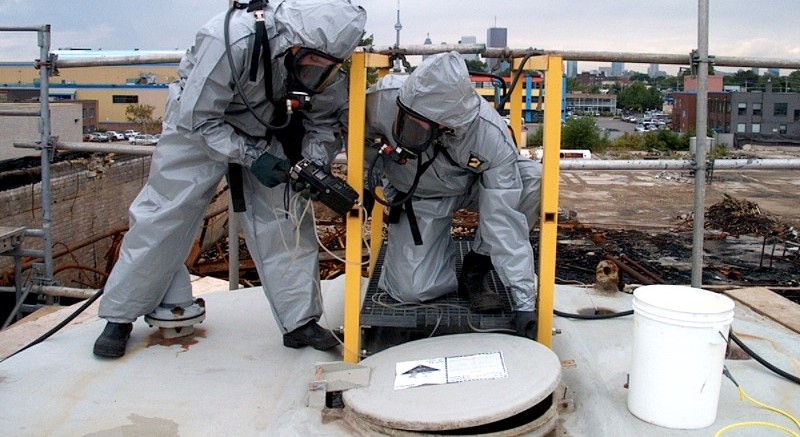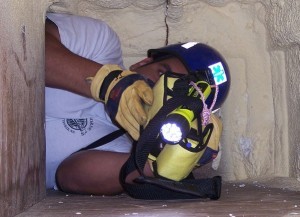In Ontario, there are two types of confined space training that you may need to take if you have confined spaces at your workplace: Confined Space Entry and Confined Space Rescue.
What’s the difference?
- Entry training is for anyone who needs to enter or perform related work around confined spaces
- Rescue training builds on Entry training and extends to anyone who may be involved with planning or implementing a confined space rescue plan in their workspace.
Click on each corresponding link to learn more:
- Why Do I Need Confined Space Training Ontario?
- Confined Space Training Ontario: Entry vs Rescue
- What Qualifies as a Confined Space?
- Frequently Asked Questions (FAQ’s)
- Why Choose ACUTE for Your Confined Space Training Ontario?
Acute has over 100 years of combined experience with in-house or on-site worker environmental and safety training. We want to help you get the training you need to keep your workers safe.
If you’re looking for Confined Space Training in Ontario, but are not sure if you need Entry vs Rescue training, we’ll explain how these two types of training differ, what they include, and who needs to take them. So, let’s get started.

Discover the difference between Confined Space Entry vs Rescue Training
Why do I need Confined Space Training Ontario?
If you work in a high risk confined space, then you are required to take confined space training. According to the Ontario’s Ministry of Labour, Immigration, Training and Skills Development Confined Spaces Regulation (O. Reg. 632/05),
Find out more about who needs Confined Space Training in Ontario.

ACUTE offers Confined Space Training for both Entry Awareness & Rescue in 3 Convenient Ontario Locations
Confined Space Training Ontario: Entry vs Rescue
To help you understand what each course entails and to determine who needs to take these courses, here is a side-by-side comparison.
Prerequisites:
None
Who Needs to Take It?
- Employers, supervisors and workers who enter or perform related work around confined spaces.
Special Requirements
- Participants need to wear appropriate CSA footwear

Program Content
This training program will familiarize you with the requirements of Ontario Regulation 632/05 – Confined Spaces. Furthermore, the training program is intended to provide entrants, attendants and competent persons the skills and training required to recognize confined space entry risks and how to establish measured and corresponding controls.
Training program topics include:
- Confined space entry accidents
- Regulation 632/05 – Confined Spaces overview
- Statutory and regulatory responsibilities
- Confined space documents
- Recognizing confined space entry hazards
- Assessing risk
- Controlling hazards
- Evaluating Control Measures
- Air Quality Monitoring
- Ventilation and purging
- Lock-out/Tag-out
- Rescue planning
- Participants will have the opportunity to become familiar with, inspect and use Confined Space Entry (CSE) access equipment and air quality instrumentation.
Prerequisites:
Who Needs to Take It?
- Employers, supervisors and workers who may be involved with planning or implementing a confined space rescue plan in their workplace.
- Confined space attendants and entry rescuers will also find this course beneficial.
Special Requirements
- Participants need to wear appropriate CSA footwear
- This program has a very significant practical component that can be physically demanding for some. Participants will have the opportunity to extricate weighted mannequins from our confined space simulators.

Program Content
This training program builds on the content of the Confined Space Entry Awareness course to train participants on the safety considerations and how to safely perform a rescue from a confined space.
Training program topics include:
- Regulation 632/05 – Confined Spaces rescue obligations and prohibitions review
- Protection of personnel from hazards within the confined space
- Size-up of existing and potential hazards in confined space emergencies
- Risk assessment
- Hazard control hierarchy
- Evaluation of controls
- Plan and implement a confined space rescue operation
- Management of the physical and psychological challenges in confined spaces
- Rescue types
- Use of victim packaging devices
- Proper lifting techniques
- Use of respiratory protection equipment and when such equipment is required for rescue operations

A confined space can be located both above or below the ground
What Qualifies as a Confined Space?
A confined space is defined as a partially or fully enclosed space that is not designed or constructed for continuous human occupancy and where atmospheric hazards could occur. This is due to its construction, location, or contents; or because of the type of work done in it.
Here are some examples of confined spaces:
- Tanks, drums
- Tank cars, holds
- Manholes, sewers, shafts
- Silos, bins, hoppers
- Tunnels, culverts
- Vaults, lockers
- Cellars, pits
- Vats, tanks, vessels, tubs
- Ditches, wells, walls, pits
- Pipelines, ducts
Confined spaces can be located both above and below ground.
Get the best confined space training Ontario has to offer from ACUTE
Frequently Asked Questions (FAQ’s)
- What is the difference between confined space entry training and confined space rescue training?
- Entry training is for anyone who needs to enter or perform related work around confined spaces. Rescue training builds on entry training and extends to anyone who may be involved with planning or implementing a confined space rescue plan in their workspace.
- What is required before entering a confined space?
- Before entering a confined space, it must be tested for oxygen content, vapour and flammable gases, and for toxic contaminants in the air.
- What is a rescue plan in confined space?
- You MUST have a written rescue plan on-site as well as readily available equipment, such as retrieval devices and breathing apparatus.
- When does confined space training expire?
- There is no official expiration date, however, it is recommended that workers participate in a refresher course once every three years at the very least.
- What are examples of confined spaces?
- Ducts, chimneys, silos, trenches, tunnels, pits, and pipes are all considered confined spaces.
Why Choose ACUTE for Your Confined Space Training Ontario?
There are many great reasons to choose ACUTE for your confined space training, here are a few:
You Can Train at Our Facilities
In addition to our training facility in Waterloo, ACUTE now offers confined space and working-at-heights training at the Levitt-Safety facilities in Port Elgin and Oakville to serve you better. Choose the training centre nearest you!
By completing your training on-site at ACUTE you can:
- Benefit from our spacious training room
- Complete your training in our state-of-the-art hands-on training space
- Enjoy the full use of our break room
We Can Come to You
We can conduct your confined space training at your facility or at our own training facility, whichever will suit your needs best. By completing your training on-site we can save your staff travel time and do your training where you will be working.
More Reasons to Choose ACUTE
With over 100 years of combined industry experience, you can trust that with ACUTE, you will experience only the best comprehensive and hands-on confined space training. Here are some ways that ACUTE goes beyond government compliance in Ontario health and safety training.
- Open Door Instructor-Student Partnership: ACUTE’s training services emphasize client participation. Staff foster relationships with clients and serve as a touchstone for advice moving forward.
- Serving Your Team and Industry: With a vast array of clients in the manufacturing, construction, health, academic, and government sectors, ACUTE brings the best safety practices from across the spectrum to your workplace.
- 100 Years of Combined Experience: ACUTE provides comprehensive health and safety training, on-site safety services, and consulting services. With over 100 years of combined experience, our staff offers more than theoretical or abstract ideas, ACUTE offers solutions.
- Track Record of Success: ACUTE is rated 4.9/5 stars on Google reviews, demonstrating a commitment to our clients, quality, and a passion for training.
“We use ACUTE for all of our training requirements. They have excellent
instructors and a great facility.”
– David – Read more testimonials here

